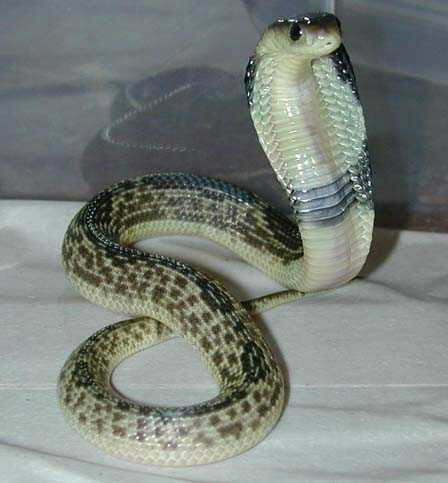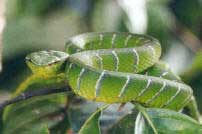The
dangerously venomous snakes in Indonesia
are mainly from three families:
1. Elapidae (Cobras,
Kraits, sea snakes and coral snakes) Sea
snakes and Kraits are more venomous than
Cobras but much less aggressive ( Krait=Ular
malas in Bahasa)
2.Vipers (ular
tanah, ular pohon) cause the most fatalities of all because their habits
bring them into contact with humans the most.
The third family of venomous snakes, the
colubrid or back fanged snakes includes garter snakes and vine snakes. These
are generally dismissed as non venomous or non dangerous, however, there are at
least two common species which have caused fatalities.Also, the toxicity of
Colubrid venom is poorly understood by scientists. Below are pictures of
examples of these three families of dangerous Indonesian snakes. ALL the examples
pictured are common in Indonesia
and are ALL dangerous with the possible exception of the Vine snake
1. Cobras
 |
| A young Javan spitting cobra |
There are three common species of Cobra in Indonesia. Their Colouration varies
from plain black, brown or olive green to barred with yellow as seen here. They
are large active and fast moving and will usually get out of your way. They
only show the neck ‘hood‘when they are cornered.
2. Kraits
Kraits are generally shy and nocturnal and
although non aggressive, they do have a habit of entering homes at night. They
have VERY powerful venom. If they do bite, you only have a 50 % chance of
surviving.
3.
Vipers
 |
| the Green Pit Viper are found around Jakarta |
Vipers are found in a range of habitats
including the branches of trees and small bushes. They are shy, tend to hide
and are difficult to see until dangerously close.
4. Colubrids
This is a large and diverse family
including Garter snakes, (top two pictures) rat snakes and vine snakes. (Bottom picture) Most are believed to be not
dangerous.
Other
groups
Sea snakes are in the Elapid family. They
are a large and diverse family. The most common species most look much like
banded kraits and are even commonly referred to as sea Kraits. They are extremely common in seas and
estuaries all over Asia. They are extremely
reluctant to bite and have very small fangs but they are all extremely
venomous. Best not to take a chance!
Sea
snake
Coral
snakes
These are related to Cobras and Kraits. Coral
snakes are burrowing snakes, similar in appearance to banded Kraits but more
brightly coloured. They are generally shy and rarely seen, they are
nevertheless very venomous.
Identification
It is clear from these pictures that the
dangerous snakes of Indonesia
come in all shapes and colours and include some very common species. The
problem is that they also vary in appearance within a species. Cobras and
Colubrid species can vary a lot in colour depending on age, Habitat and
moulting stage. This can cause fatal mistakes.
Effect
of Bites
Bites from Cobras and Vipers are very
painful and leave you in no doubt that you have a problem, but bites from
Kraits, Sea snakes and Colubrid snakes have almost no immediate effect and can
cause fatal mistake number two; ‘it doesn’t hurt so it must be a harmless
species’ In the case of Kraits by the
time you start to get symptoms there will be nothing a hospital can do. In the
case of the most dangerous colubrid species, the serious symptoms often take as
long as day to appear. The clinical effects range from paralysis (Kraits and
sea snakes) to blood disorders such as excessive clotting or bleeding (vipers and
Colubrids) or in some case, a mixture of these. (Some vipers and Cobras).
Treatment
Because of the problems with Identification
and lack of symptoms ALL snakebites by wild snakes should be treated as
serious. People bitten by pythons may disagree but I know many people who have
misidentified pit vipers as baby pythons!
The following recommended course of action
has been composed from surveys done in India and Asia
including data on survival factors from tens of thousands of cases.
- Don’t waste time with fist aid, tourniquets, sucking out the poison and the like. Get help, you will need to get to hospital quickly. You should rest as much as possible so you will need someone to transport you unless the hospital is close.
- Go to a modern, well equipped hospital with the following facilities: Intensive care unit with equipment for assisted breathing, heart monitoring and emergency resuscitation. This is to deal with the effects of respiratory and cardiac failure resulting from cobra or krait bites. You will also need facilities to deal with transplants of blood, plasma etc and dialysis. This is in the event of bites by vipers or colubrids which can cause kidney failure.
- Get as much information as possible about the snake, Have someone find it, kill it and bring it with you if possible but failing that, get pictures and try to identify it (you may need help with this!) Hospitals in Indonesia are not usually staffed by snakebite experts and they will need all the help they can get.
- Antivenin (antivenom) should only be used if it is made from the same species and comes from the same country as the snake. Antivenin treatment is risky since there it usually causes a severe allergic reaction and it is only worth the risk if it is done exactly right.
source: http://www.expat.or.id/medical/poisonoussnakes.html





No comments:
Post a Comment